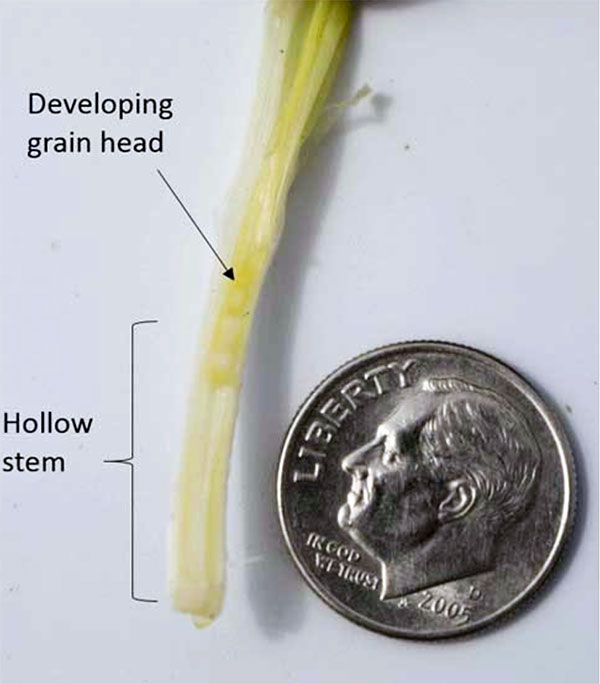
In the Southern Great Plains, winter wheat is a staple grazing forage in the fall and spring. For some producers, wheat serves as a bridge to perennial pastures, while others will use the wheat crop as forage and for grain.
For those using wheat as a dual-purpose crop, the timing of cattle removal in the spring has a profound impact on the subsequent potential grain yield.
Kansas State University’s Romulo Lollato notes that once the wheat plant’s embryo head has developed, the first stem internode will begin to elongate, pushing the future seedhead up through the leaf sheaths. This first internode will be hollow and visible before you can feel the first stem node.
“First hollow stem is the point at which a 1.5-centimeter (about a half-inch) length of hollow stem can first be identified below the developing head,” Lollato explains. “This length is roughly equivalent to the diameter of a dime, which makes it easy to measure in the field. First hollow stem occurs when the developing head is still below the soil surface. This means that producers must dig plants out of the ground to measure it,” adds the forage and wheat extension specialist.

To look for the first hollow stem, Lollato says to start by digging up some plants from fields or areas that have not been grazed, such as field corners or just outside the fence. The date when the first hollow stem appears is variety and field specific, so samples need to be obtained from each individual field.
“Select the largest tillers to examine and slice the stem open from the crown area up,” Lollato says. “Look for the developing head, which will be very small. Next, see if you can find any hollow stem between the developing head and the crown area.”
Separation between the growing point and crown is a sign that the hollow stem is elongating. If that separation is 1/2 inch, the wheat plant is at first hollow stem and cattle need to be removed to preserve grain yield. First hollow stem occurs between a few days to a week or more prior to jointing, depending on weather conditions.
“Yield losses from grazing after first hollow stem can range from 1% to 5% per day, depending on grazing intensity and the weather following cattle removal,” Lollato asserts. “If cattle removal is followed by cool, moist weather, yield losses will often average about 1% per day grazed after first hollow stem; if the weather is hot and dry, yield losses of 5% per day or more can be expected.”
To help producers monitor wheat development, Kansas State University reports the hollow stem length progression of 19 different varieties.

